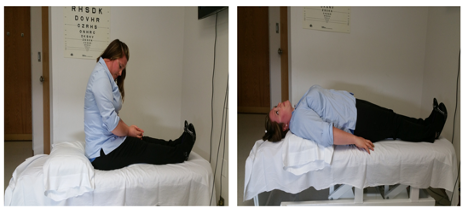The Loaded Dix-Hallpike: An Update in BPPV Testing
Optimizing tests to identify BPPV is important since it is quite common and amenable to treatment. Adding the Loaded Dix-Hallpike to your testing toolbox for patients who present with positional vertigo may enhance your ability to identify BPPV, allowing for prompt and appropriate treatment.
September 13, 2021
3 min. read

Benign paroxysmal positional vertigo (BPPV) is a common condition in adults. It's typically caused by displaced otoconia from the utricular maculae, which become entrapped in the posterior semicircular canal. The condition is usually amenable to treatment with physical repositioning maneuvers.
An Alternative to Traditional Dix-Hallpike Testing
A recent paper demonstrated that reduced responses with Dix-Hallpike testing are more likely if particles are displaced a further distance away from the cupula along the inferior plane of the posterior canal.1 Loaded Dix-Hallpike testing has been proposed as an alternative to traditional Dix-Hallpike testing.2 The purpose of the Loaded Dix-Hallpike test is to better ensure responsiveness with Dix-Hallpike testing and potentially reduce false negatives.
Performing the Loaded Dix-Hallpike Test

Perform a right-sided Loaded Dix-Hallpike by rotating the head to the right 45 degrees, flexing the head 30 degrees in the plane of the right posterior canal, and then holding for 30 seconds prior to lying your patient flat on their back. The flexion is theorized to migrate the debris toward the posterior canal cupula. The ear-dependent supine position is no different than traditional Dix-Hallpike testing.
3 Reasons to Use the Loaded Dix-Hallpike
Loaded Dix-Hallpike testing appears to increase the likelihood of evoking a positive response in individuals with BPPV. This enhances your ability to promptly identify BPPV.
Increased duration of nystagmus tends to be evoked with Loaded Dix-Hallpike testing. This gives you a longer observation period to identify the presence and direction of nystagmus.
Negative Loaded Dix-Hallpike testing following canalith repositioning maneuvers may further enhance your confidence in your patient's responsiveness to treatment.
2 Reasons Not to Use the Loaded Dix-Hallpike
The reported severity of dizziness-related symptoms tends to be stronger with Loaded Dix-Hallpike testing. This may result in the testing being more uncomfortable for your patient. Although not formally studied, the risk of nausea and vomiting may be higher with Loaded Dix-Hallpike testing.
While not technically complex or requiring additional equipment, Loaded Dix-Hallpike testing requires approximately 30 more seconds than traditional Dix-Hallpike testing. If testing is completed with each posterior canal twice during an exam, an extra two minutes are required for the examination.
Optimizing tests to identify BPPV is important since it is quite common and amenable to treatment. Adding the Loaded Dix-Hallpike to your testing toolbox for patients who present with positional vertigo may enhance your ability to identify BPPV, allowing for prompt and appropriate treatment.
Below, watch Jeff Walter compare standard and loaded Dix-Hallpike testing in a short clip from his MedBridge course, "Diagnostic Maneuvers for BPPV."






